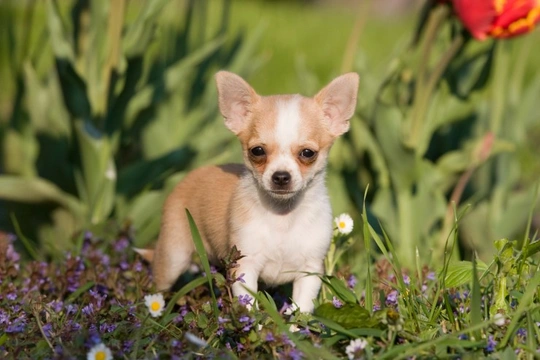
When will my Chihuahua’s ears stand up?
The Chihuahua is the smallest dog breed in the world, and they’re also really popular too, being ranked as the second most popular dog breed in the UK overall.
The very small size of dogs of the breed and their quite distinctive appearances mean that virtually all dog lovers will be able to identify a Chihuahua when they see one, and the breed’s popularity means that it isn’t hard to find out all about the breed and its core traits in detail if you are thinking of buying a Chihuahua puppy.
However, as is the case with many things in life, any first-time Chihuahua puppy buyer is apt to find themselves with some questions that aren’t so easy to find the answers to, but that can help you to know what to expect from your pup’s growth and development.
One such question is “when will my Chihuahua’s ears stand up?” Chihuahua puppies are born with folded over or floppy ears, which only begin to stand up as the dog gets older and the muscle and cartilage of their ears becomes stronger and allows the ears to stand erect.
However, a small number of Chihuahua puppies retain their folded over ears for life – and in this article we will explain a rough timeline of when you can expect a Chihuahua puppy’s ears to stand up, and when you will be able to tell if they’re not going to do so. Read on to learn more.
Early development
New born Chihuahua puppies are born with ears that are folded over or floppy, and it takes several weeks for their ears to develop and grow the strong cartilage and muscle that causes the ears to point upwards in the manner that we associate with the breed.
This means that if you go to view a litter of Chihuahua puppies when they are young with a view to reserving one to buy later on, you might get to see the litter with floppy ears.
The ears of Chihuahua pups don’t go from floppy to upright overnight, and the process takes several weeks to complete. Generally a twelve week old pup’s ears will be beginning to stand up, but there is no set timeline for this and some pups may develop upright ears a little earlier, or a little later.
How teething can affect your Chihuahua’s ears
Even if your Chihuahua pup’s ears seem to be following a fairly linear progression to becoming upright, you might find that this all changes when your dog starts teething. Some Chihuahua pups whose ears are beginning to become erect or whose ears seem to have made it all the way will actually begin to droop again as they start to grow their adult teeth in, at between four and five months of age.
This is common within the breed, but doesn’t happen to every dog – and it might only affect one ear and not both, to further compound the confusion!
However, if your pup’s ears were already erect or beginning to become erect before they started teething, they will almost certainly do so again once your pup has all of their adult teeth in place.
When will I know if my pup’s ears are going to stand up?
If your pup gets to the age of around eight to nine months old and their ears are still floppy and aren’t showing any signs of starting to stand up, there’s a good chance that they’re not going to.
While the vast majority of dogs of the breed have erect ears when adult, this isn’t true for all Chihuahuas. For breeders who are seeking to produce show quality dogs, this is classed as an undesirable trait, and means that the dog probably won’t do well in the show ring.
However, floppy ears aren’t a problem for the dog at all, and won’t affect your Chihuahua’s hearing – it will just give them a unique and distinctive appearance.
Because floppy ears are associated with Chihuahua puppies rather than adult dogs of the breed, floppy ears that are retained into adulthood can give your Chihuahua a very youthful, puppy-like appearance and help to contribute to their cute-appeal.
However, dogs whose ears fold over or drop down rather than standing upright tend to have a slightly higher risk of suffering from problems such as ear mites or ear infections, and so you should check your dog’s ears regularly and clean them when necessary.
Look for signs of problems like inflammation, soreness or redness, or signs of mites and other parasites like an excessive amount of earwax production or a dark muck within the ears that can look like coffee grounds. This may indicate the presence of ear mites, which can be treated using products your vet will provide when you take your dog along to the clinic for diag



